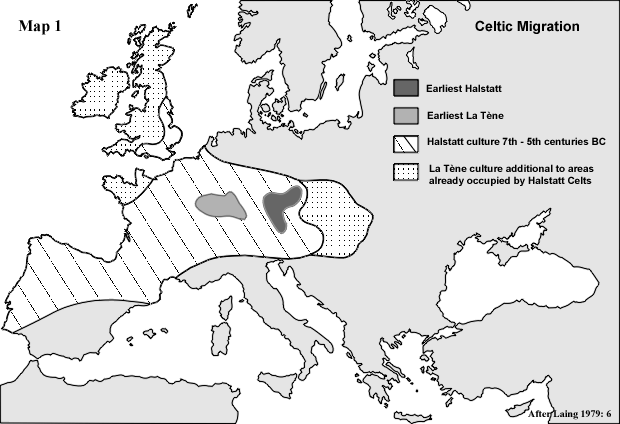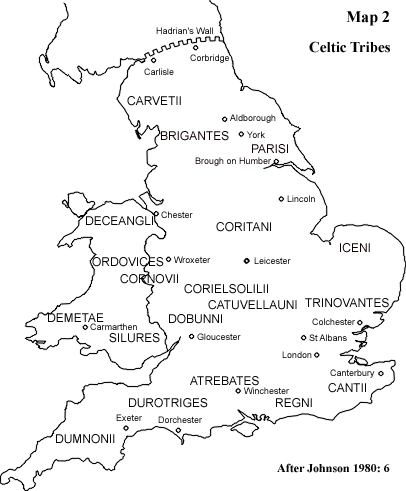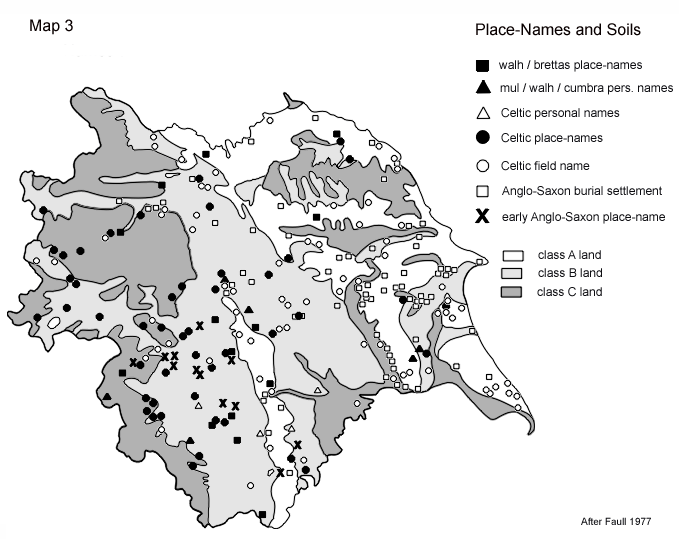

 |
|
 |
| "The earliest of the Indo-European migrations to the British Isles within the range of recorded history was that of the Celts, whose descendants still live in a broad crescent extending from Brittany in north-western France through Cornwall, Wales, the Isle of Man, Ireland to the the Highlands of Scotland." (Hughes, 2000: 73) |
Overview
The Celts, whose names is derived from Keltoi, the name given to them by the Greek historian Herodotus, originated within that region of Europe which approximates to present-day France and western Germany. The evolution of these people began with the Halstatt Celts, an Iron Age culture named after the location of an early Celtic burial site in the Salzkammergut. However, in the latter part of the 6th century BC, a new and more highly developed Celtic people evolved around the areas of the Marne and middle Rhône. These were the La Tène Celts, their name being derived from a site of archaeological investigation on the shores of Lake Neuchâtel. They were distinguishable from the Halstatt by their burial rite of interning a two-wheeled chariot (as opposed to a rustic wagon) with their deceased elite. These new arrivals gradually took control of the areas formally falling under the dominion of the Halstatt (see Map 1).
 |
The 5th and 6th centuries BC were the greatest phase of Celtic affluence and expansion. It was at the beginning of this period that the migration from the Continent commenced when the Halstatt spearheaded the advance into Britain and the ultimate replacement of the indigenous Bronze Age culture. The in-migration of the La Tène Celts began around the mid 3rd century BC and archaeological evidence suggests that, before the close of the 2nd century BC, there was a significant influx of this culture into East Yorkshire. A further hundred years saw the establishment of the La Tène in all parts of Britain.
It was about the 1st century BC that the last stage of Celtic settlement materialized. Known to Caesar as the Belgae, the newcomers came from those territories situated to the south of present-day Belgium. This colonization of the south-east of Britain has the distinction of being the only Celtic migration to be documented.
Settlement
The Halstatt Celts colonized southern and eastern parts of Britain initially settling around the coastal regions of England and Wales. Over the next two hundred years or so they spread out along the Welsh Marches, into the Midlands and over to the Pennines. This culture actually formed the majority of the Celtic population down to the Roman conquest.
With regard to the La Tène Celts, primary settlement occurred in the areas of the south-west and present-day Sussex. It is conjectured that numbers were probably small but there is evidence to suggest that they moved as complete families or in other types of social group. In the north, they populated the Yorkshire Wolds and possibly spread into the south-west of Scotland. It appears that , rather than driving out the existing settlers, the La Tène either set up their own cultural enclaves or became overlords of the existing population.
Settlement in Yorkshire
Map 2 identifies the different Celtic tribes and their locations. As can be seen, the inhabitants of the area of what is now Yorkshire consisted of two groups: the Brigantes and the Parisi. The former was the larger of the two tribes and their domain, the capital of which was Aldborough in the North Riding, covered a large part of northern England. The Parisi, whose tribal capital was situated at Brough on Humber, occupied the region equating to the present-day East Riding.
 |
In relation to post-Roman settlement, Faull (1977) draws attention to the fact that the few areas for which evidence of such settlement exists display a remarkable absence of British place-names. For example, there are no such names in the North Yorkshire Moors, the Howardian Hills or Upper Nidderdale, all of which are likely to have contained a significant Celtic population (see Jones, 1975).
Referring to Fellows Jensen (1972) and remarking on the high degree of Scandinavian settlement, especially in the East Riding, she also suggests that later in-migrations may account, in part, for the scarcity of British place-names in the county. For example, she observes that the only British place-names in the East Riding are Craike Hill, Leven in Holderness and, possibly, Beverley.
Similarly, in the North Riding, Celtic place-names are conspicuously non-existent in the areas of the 6th century English coastal settlements and the 7th century settlements in Wensleydale and the Howardian Hills. A sprinkling of such names exists in the Vale of York e.g.: Leeming, Catterick, Alne and Crayke (with regard to Crayke, there is evidence that a Romano-British settlement was located there in the latter part of the 4th century).
In contrast to the above, the West Riding around the region of Elmet contains a large number of British place-names.
Overall, examining the locations of British settlements in relation to soil quality, Faull considers that the general pattern appears to be the complete linguistic suppression of the Celts "in the most fertile areas of the county". Map 3 summarizes the position. Soil quality is described by Faull in the following terms: Class A "high quality land"; Class B "land suitable for agriculture but with some disadvantages"; Class C "very poor moorland and mountain soils and the heavy clays"
 |
Names in walh in Yorkshire generally tend to be located on the margins of Class A land. It seems that the British settled the best sites remaining after the Anglo-Saxons had occupied their land of the choice, i.e. the best locations. However, in the West Riding walh sites are liable to be found on the comparatively inferior B and C lands at some distance from the "early English settlements".
Further details of the walh, cumbra etc place-names may be accessed by clicking here. The British names can be found in the page devoted to Celtic Place-Names.
Sources
Barber, C. (1993) The English Language - A Historical Introduction, Cambridge: CUP
Faull, M L (1977) British Survival in Anglo-Saxon Northumbria. In Lloyd Laing (Ed) (1977) Studies in Celtic survival, British Archaeological Report 37
Fellows Jensen, G,. (1972) Scandinavian Settlement Names in Yorkshire, (Copenhagen, 1972)
Hughes, G. (2000) A History of English Words, Oxford: Blackwell
Johnson, S. (1980) Later Roman Britain, London: Book Club Associates.
Jones, G. R. J. (1975) Early territorial organization in Gwynned and Elmet, Northern History, X (1975), 3-27.
Laing, L. (1979) Celtic Britain, London: Routledge and Kegan Paul.
Powell, T. G. E. (1980) The Celts, New Edition, London: Thames and Hudson.
Thurlow, W. (1979) Yorkshire Place-names, Clapham, North Yorkshire: Dalesman pubishing.